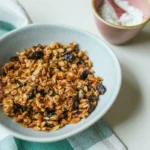For individuals managing diabetes, dietary choices play a pivotal role in maintaining stable blood sugar levels and promoting overall health. Among staple foods, rice is a common component in many diets, particularly in Asian countries.
When it comes to rice consumption, brown rice consistently emerges as a superior choice compared to white rice for diabetic patients. This preference stems primarily from brown rice’s lower Glycemic Index (GI). The GI is a measure of how quickly a food raises blood sugar levels after consumption. With a significantly lower GI, brown rice helps to prevent the rapid spikes in blood sugar that can be detrimental to diabetic health.
However, even with its advantages, the key to incorporating brown rice safely into a diabetic diet lies in moderation and mindful consumption. It is essential to integrate it alongside foods that are rich in fiber and protein, which further help to slow down glucose absorption and promote satiety. Additionally, engaging in light physical activity after meals can contribute significantly to maintaining healthy blood sugar levels.
According to Dr. Tran Thi Tra Phuong from the Department of Diet Regulation at Tam Anh General Hospital in Hanoi, brown rice boasts a GI of below 55, in stark contrast to white rice, which has a GI of 76. This lower GI means that the carbohydrates in brown rice are absorbed much more gradually into the bloodstream, facilitating better blood sugar regulation. Beyond its GI benefits, brown rice retains its bran and germ layers, which are veritable powerhouses of nutrition, packed with fiber, essential vitamins, vital minerals, potent antioxidants, and beneficial protein. These components are crucial for reducing inflammation, improving insulin sensitivity, and fundamentally supporting overall health in diabetic patients.
Nutritional Benefits Beyond Blood Sugar Control
Brown rice offers a spectrum of health advantages, contributing to overall well-being for diabetic patients.
Promoting Satiety and Weight Management
Beyond its immediate impact on blood sugar, the nutritional composition of brown rice plays a significant role in broader health management for diabetic patients. One of its key benefits is its ability to help with satiety. The high fiber content in brown rice, particularly from its intact bran layer, swells in the digestive system, creating a feeling of fullness that lasts longer.
This sustained satiety is crucial for weight management, a critical aspect of diabetes care. Managing weight effectively can significantly improve insulin sensitivity and reduce the overall burden of the disease. By feeling fuller for longer, diabetic patients are less likely to overeat or consume unhealthy snacks between meals, which directly supports stable blood sugar levels and contributes to a healthier body weight.
Furthermore, brown rice’s rich fiber content also has a positive impact on improved cholesterol levels. Soluble fiber, abundant in brown rice, helps to reduce low-density lipoprotein (LDL) cholesterol, often referred to as “bad” cholesterol, by binding with it in the digestive tract and facilitating its excretion. Lowering LDL cholesterol is essential for reducing the risk of cardiovascular disease, a common complication for individuals with diabetes.
The synergy of fiber, antioxidants, and other micronutrients in brown rice also contributes to a reduced risk of certain types of cancer, showcasing its comprehensive health benefits beyond just glycemic control. Additionally, the presence of vitamin B content in brown rice is vital for the body’s metabolic processes. These B vitamins play a key role in supporting red blood cell production and ensuring efficient energy metabolism, which are fundamental for maintaining vitality and preventing fatigue in diabetic patients.
Expert Tips for Safe Consumption
Dr. Phuong provides practical guidelines for diabetic patients to incorporate brown rice effectively and safely into their diet.
1. Prioritize Low GI Varieties
When selecting brown rice, diabetic patients should be discerning. Dr. Phuong emphasizes the importance of choosing low GI rice. It is a common misconception that all brown rice varieties have the same glycemic impact. In reality, there are various types of brown rice, and some indeed possess a lower Glycemic Index than others.
To maximize the benefits, it is crucial to opt for brown rice with an intact bran layer. This intact layer is the primary source of the fiber, vitamins, and minerals that make brown rice a healthier option. Heavily processed versions, even if labeled “brown,” may have had some of their bran or germ removed, leading to less nutritional value and potentially a slightly higher GI. Patients should look for whole grain labels to ensure they are getting the most beneficial product.
2. Implement Strict Portion Control
Even though brown rice is a healthier alternative, it remains a carbohydrate. Consequently, it can still influence blood sugar levels if consumed in excessive quantities. Dr. Phuong underscores the necessity of controlling the amount of brown rice per meal. Diabetic patients should aim to limit their daily carbohydrate intake to about 55% of their total calories. While this provides a general guideline, the exact safe amount of brown rice can vary significantly based on individual factors.
These include a patient’s activity level (more active individuals may tolerate more carbohydrates), their weight, and their individual response to carbohydrates. What works for one person may not work for another, making personalized guidance crucial. Therefore, it is absolutely essential to consult with a doctor or a registered nutritionist to determine the appropriate portion size tailored to each patient’s specific needs and health profile. This personalized approach helps ensure that brown rice contributes positively to blood sugar management without causing adverse effects.
3. Strategic Food Pairings for Balanced Nutrition
To optimize the benefits of brown rice and minimize blood sugar spikes, strategic food pairing is critical. Dr. Phuong advises diabetic patients to avoid pairing brown rice with sugary or refined starch foods. These combinations can lead to a rapid increase in blood glucose. Instead, the recommendation is to combine brown rice with a variety of other nutritious foods that complement its slow-release carbohydrate profile. Ideal companions include an abundance of non-starchy vegetables, such as leafy greens, broccoli, and bell peppers, which are rich in fiber and micronutrients without significantly impacting blood sugar.
Fresh fruits (in controlled portions) and legumes (like lentils, beans, and chickpeas) are also excellent choices, providing additional fiber, vitamins, and plant-based protein. Crucially, pairing brown rice with lean proteins such as chicken breast, fish, tofu, or eggs helps to further balance nutrition and significantly slow down sugar absorption.
Protein and fiber both contribute to a lower glycemic response and enhance satiety. The American Diabetes Association (ADA) provides a clear and actionable guideline for meal planning: they recommend a balanced plate composition with 25% dedicated to brown rice or other starches, 50% to non-starchy vegetables, and the remaining 25% to lean protein. This visual guide simplifies meal preparation, ensuring a well-rounded and blood-sugar-friendly meal.
4. Mindful Preparation Methods
The way brown rice is prepared can significantly influence its Glycemic Index. Dr. Phuong highlights that cooking methods impact brown rice’s GI. When brown rice is exposed to very high heat, the starch within its grains can undergo changes, breaking down more rapidly and forming a gel-like consistency. This process can inadvertently increase the GI, making the carbohydrates more readily absorbed and potentially leading to higher blood sugar spikes.
To keep the GI as low as possible, steaming is identified as the best method. Steaming gently cooks the rice, preserving its structural integrity and minimizing starch gelatinization. Other beneficial cooking methods include boiling or cooking in a pressure cooker or a standard rice cooker. These methods also generally result in a lower GI compared to high-heat, high-fat cooking. Conversely, Dr. Phuong strongly advises to avoid frying or stir-frying brown rice.
While popular in some cuisines, these methods invariably involve the addition of oils and often sugars, which dramatically increases its unhealthy content for diabetic patients, negating many of the benefits of choosing brown rice in the first place. Therefore, prioritizing gentle, moist-heat cooking methods is crucial for maximizing the health benefits of brown rice in a diabetic diet.
5. Diversify Carbohydrate Sources
While brown rice offers numerous benefits, a balanced diet for diabetic patients necessitates variety. Dr. Phuong advises against consuming brown rice exclusively or too frequently due to the presence of phytic acid, or phytate. Phytic acid is a naturally occurring compound found in many plant seeds, including whole grains like brown rice. While it has some health benefits (like antioxidant properties), it can also interfere with the absorption of essential minerals, such as calcium, iron, and zinc, when consumed in large quantities consistently.
To mitigate this potential issue and ensure a comprehensive nutrient intake, diabetic patients should alternate brown rice with other healthy starch sources. This dietary diversity provides a wider range of vitamins, minerals, and dietary fibers. Excellent alternatives include potatoes (especially sweet potatoes, which have a lower GI), oats (a rich source of soluble fiber), quinoa (a complete protein and gluten-free grain), or various legumes (such as lentils and beans, which are high in fiber and protein).
By incorporating these diverse options into their diet, patients can achieve a more balanced nutritional profile, prevent potential mineral deficiencies, and maintain better overall glycemic control, ensuring that their carbohydrate intake is both healthy and varied.
6. Consistent Blood Sugar Monitoring
The impact of food on blood sugar levels is highly individualized, even for seemingly healthy options like brown rice. Therefore, regular monitoring of blood sugar is paramount for diabetic patients. Dr. Phuong emphasizes that each individual reacts differently to brown rice, making personal observation essential. Patients should consistently monitor their blood sugar levels after meals that include brown rice. This practice provides direct, real-time feedback on how their body processes the carbohydrates in the rice.
If blood sugar levels rise significantly or unexpectedly after consuming brown rice, it serves as a clear signal that adjustments are needed. This might involve modifying portion sizes to a smaller amount, or even changing cooking methods to further lower the glycemic impact. Continuous monitoring allows for personalized dietary adjustments, ensuring that brown rice is incorporated in a way that actively supports, rather than hinders, stable blood glucose control.
Furthermore, Dr. Phuong notes a crucial consideration: the high fiber content in brown rice, while generally beneficial, may cause digestive issues for certain individuals. This includes people with pre-existing digestive disorders (like irritable bowel syndrome), those experiencing indigestion, or patients who have recently undergone digestive surgery. For these individuals, a gradual introduction or even temporary avoidance of high-fiber foods like brown rice may be necessary. In all cases, regular monitoring and adjustment of diet are identified as key strategies for maintaining optimal health and managing diabetes effectively.
Empowering Diabetic Patients with Smart Choices
For diabetic patients, the journey to effective health management is deeply intertwined with informed dietary choices. Brown rice stands out as a significantly healthier alternative to white rice due to its lower Glycemic Index and rich nutrient profile, offering benefits that extend far beyond simple blood sugar control to include improved satiety, weight management, and reduced risks of cardiovascular disease and certain cancers.
However, as Dr. Tran Thi Tra Phuong meticulously outlines, maximizing these benefits and ensuring safe consumption requires a strategic approach. This involves a crucial focus on portion control (around 100 grams per meal), selecting low-GI varieties with intact bran, and thoughtfully combining brown rice with nutrient-dense foods like lean proteins and non-starchy vegetables.
Furthermore, mindful preparation methods like steaming and diversifying carbohydrate sources are essential for comprehensive health. Ultimately, regular blood sugar monitoring remains the cornerstone, empowering individuals to fine-tune their diet for optimal health. By adhering to these expert guidelines, diabetic patients can confidently incorporate brown rice into their diet, transforming it into a powerful ally in their journey towards balanced health and well-being.








